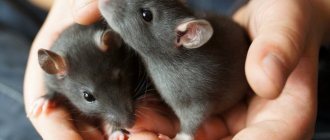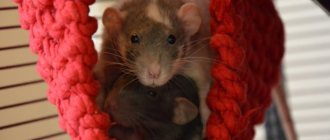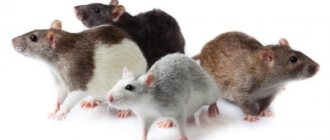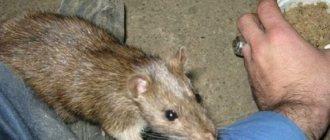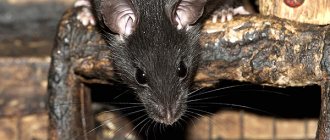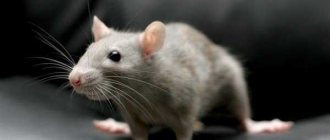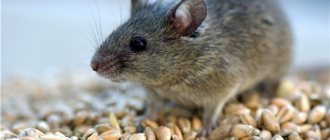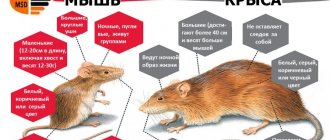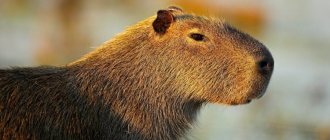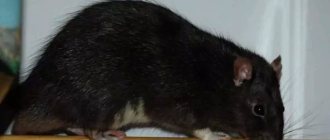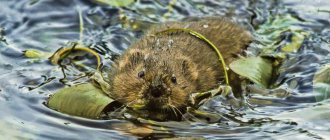Rats can eat any food and are prone to overeating. Therefore, they can quickly gain unhealthy weight. This can lead to serious illness.
If you want your rodent to remain healthy, you need to monitor its weight. It is important to know the standard parameters of rats to determine whether the animal is developing properly and what its health status is.
What determines the size and weight of rats?
The body weight and size of a rodent depends on several factors:
- The species to which the animal belongs. For example, small rats (Rattus exulans) weigh about 70 g and are only 14 cm long. But pasyuks, which are familiar to humans, grow to 20-25 cm and gain a weight of 200-390 g.
- Gender of the rodent. Males, both in nature and among ornamental representatives of this species, are approximately 10-15% larger than females.
- Hereditary data. If the cub's parents are small, then it is unlikely that it will grow into a large rat. This also works in the opposite direction. In large individuals, the appearance of small offspring indicates some kind of pathology or unfavorable factors during the female’s pregnancy.
- Food and living conditions. The ability to obtain adequate nutrition directly affects how much a rat will weigh. If during pregnancy the female does not receive adequate food, the offspring will be more frail. Vitamin and mineral deficiencies during infancy also affect adult size. The animal will be weak and noticeably smaller than its fellows.
- A calm, comfortable environment has a beneficial effect on the weight of animals. A state of constant stress can inhibit development in small rodents.
- Health. The size of an adult rat is directly related to the condition of its body. Of course, it will not become larger than the parameters assigned to it by nature, but excessive thinness and weight loss are direct evidence of an illness in the animal.
Homemade
Measuring the mass of a rodent is simple; just place it on some sensitive scale. Kitchen ones are also suitable. But there are problems with measuring length. The plastic structure allows them to both stretch the body and compress it. The difference in numbers will be colossal.
Grooming
They constantly need to comb their white fur, and they also need to be washed constantly. To comb the rodent, use a toothbrush, and be sure to have a soft one. While combing, you will have to hold the rodent with your thumbs and forefingers.
If you find yellowness in your pet's fur, then this is a reason to worry. It is possible that your rat is sick and is unable to care for itself.
Important! You should not risk the animal's psyche if you decide to clean the fur by washing it in a basin. You can simply wet cotton pads and wipe your pet's fur
After the procedure, you need to wipe the rodent dry.
Place the cage with the animal away from direct sunlight, as white rats are afraid of bright sunlight.
The largest and smallest rats in the wild
Species of rats differ among themselves in their habitat (some prefer to live close to humans, others far away), in size, and taste preferences. People have known some of the representatives of rodents since ancient times, and some they met quite recently.
- The giant Papuan or Bosavi woolly rat does not even have a scientific name yet. It was discovered in 2009 on the island of Papua, which belongs to the territory of New Guinea. It received its temporary name due to the crater of the Bosavi volcano, where it was discovered. Perhaps it can be considered one of the longest rats, since the size of the body reaches 1 meter, plus a tail of about 30 cm.
- Cane rats or bristle pigs are real giants. Despite the body length of 55-60 cm, the weight of females reaches 4-5 kg, and in males it can reach up to 9 kg. They live in equatorial and southern Africa.
- In Russia, the largest breed is the pasyuk or gray rat . Its body length is 17-25 cm, and its weight is 140-390 g.
- The size of the smallest rat found in the wild barely reaches 11–15 cm, weight from 40 to 80 g. The little ones live in New Guinea, the Pacific Islands, and Southeast Asia. In addition to the official name - small , they are also called Pacific or Polynesian .
Children's legends about mutant rodents that appeared due to environmental problems do not have any supporting facts.
Justified and unfounded fears
In the last century, Moscow newspapers published an article about giant species of rats that were found in the outback of the local metro. They began to crawl to the surface and attack people. The giant rats were similar in size to dogs, had red eyes, yellow plaque on their teeth, and a terrible grin. Large monsters with a terrifying appearance.
With the development of the global Internet, horror stories about rodents increasingly began to appear on the pages of websites. The Chinese presented a photo of the largest rat in the world, holding the huge monster by the tail. The weight of the animal reached several kilograms.
Thanks to such horror stories, people began to have justified and unfounded fears. No one wants to meet a hungry monster with a terrible look on their way. How big can a rat grow? Is there any reason to worry?
The largest city rats
City rats are the same animals that live in rural areas. For a long time, black representatives of this family settled in the attics and basements of houses, lurked around the streets and spoiled the supplies of the townspeople, and served as a source of various diseases. In the 18th century, gray rats began to spread from port cities throughout Europe. Larger, aggressive, eating not only grain reserves, but also meat products, they became a disaster.
A big street rat could drag away a chicken, attack a small child, and, driven into a dead end, bravely fought with cats and dogs. Gradually displacing black rats, pasyuks began to spread throughout all the countries where people live. The most important thing for these animals is the availability of water and food. The only place they avoid is heights. It is almost impossible to meet them on the upper floors of skyscrapers. That's why there are still black rats there, which prefer dry attics. The native element for gray rodents is basements, communications, metro lines, sewers.
Wild animal
Any measures to destroy pasyuks only temporarily reduce their colonies. Smart animals with a clearly constructed hierarchy and defined roles within the group never risk the entire flock. They quickly learn to avoid any human traps and can temporarily leave dangerous territory. But as soon as the colony grows, everything will return to normal.
Cell selection
In order for your pet to feel great, you need to purchase a spacious cage with a set of all the necessary accessories and balanced food. You should always remember that the cage for a fluffy rat plays a very important role, since he spends most of his life in it. Therefore, when choosing a cage, you should be guided by the following requirements.
Cage dimensions
It is not recommended to keep your pet in a cramped cage, as the animal likes to move a lot. As a rule, the optimal cage dimensions are within the following limits: cage width – 40 cm, cage length – 60 cm and cage height – also 60 cm. For such an animal, this space is absolutely enough. The distance between the cage bars should be no more than 1.2 cm.
bottom of the cage
For such rodents, a solid floor is more suitable, since a lattice floor leads to injuries to the rodents’ limbs.
Cage tray
The starting material for the pallet is durable plastic. The pallet should have high sides to prevent the filler from spilling out. The pallet should not be made of wood, since wood will absorb urine, which will cause an unpleasant odor in the home.
Cage design
The best option is a collapsible cage with large doors to make it convenient to clean, wash, feed and hang various elements. The cage must have shelves for animals to rest.
Cage coating
As a rule, cage rods are coated with enamel, zinc or powder paint, which is not critical. The main thing is that the coating is of high quality, without chips or rust.
Size and weight of pet rats
Artificially bred decorative rats are increasingly winning the love of humans. Having been born less than 70 years ago, thanks to a strict selection of producers, we managed to obtain affectionate, peace-loving and intelligent animals. Breeders, taking advantage of the rapid emergence of the next generation in these rodents, are excitedly developing new breeds.
Despite the fact that pets are all approximately the same size, there are several species with the largest rats.
- Brown. On average, the animals weigh 500-600 g, but some specimens reach 900 g. Although this cannot be called the norm. It is possible that the rodents are obese. Representatives of this species live only two years.
- Standard. One of the most common breeds. Affectionate and non-aggressive rodents rarely bite despite their very large size for an ornamental rat. They weigh up to 500 g, body length is about 30 cm.
- Dumbo. Representatives of this species were bred in California. Their large protruding ears give their faces a funny expression. The value of a breed representative is determined by the length of the ears. They grow up to 20 cm and gain a weight of about 400 g.
Features of feeding a rodent
The domestic decorative rat is an omnivore, but this does not mean that you can feed it just anything. Her health depends on the quality of her diet. The basis of the diet is cereals. You can offer buckwheat, rice, corn, barley or wheat raw or after cooking, but without salt.
The rodent will happily eat flax seeds, pumpkin seeds or nuts. Vegetables and greens are sources of vitamins. The domestic ornamental rat loves broccoli, carrots, cucumbers, zucchini and eggplant. In summer you can treat her with dandelion leaves, plantain leaves, and a small amount of parsley.
Meat is a source of animal protein. You can give your pet a chicken egg, boiled boneless fish, poultry fillet, as well as offal - hearts or stomachs.
Fermented milk products help improve digestion and strengthen the rodent's immunity. The domestic decorative rat loves kefir, classic yogurt and low-fat cottage cheese. Sometimes you can pamper your rodent with a piece of apple, grape or watermelon.
A decorative pet rat should not be fed:
- sweets - candies, chocolate;
- spicy, salty or fried foods;
- potatoes;
- fresh cabbage;
- spinach;
- tomatoes;
- onions;
- garlic;
- unripe bananas;
- fatty foods.
Important! The rodent should not be overfed. A fat rat is susceptible to diseases of the cardiovascular and endocrine systems.
Average size of baby rats based on their age
Rats are born blind, without fur and with closed ears. Weight at birth is only 4-6 g. Thanks to the mother's nutritious milk, babies grow quickly, adding 2-3 grams every day.
Already on the 10th day of life, they hear well, are covered with fluff, and begin to actively explore the available space. Their body weight increases 6 times during this time.
After 20 days from the moment of birth, rats become similar to adults and grow to a size of about 15 cm.
On the 25th day, the babies are separated from their mother, otherwise the female will independently expel the offspring from the nest into an independent life.
Active growth of young animals continues up to 6 months, but a rat can reach its maximum size only by the age of one year.
Young animals
Approximate weight of the animal depending on age:
- Newborn – 4–6 years.
- 2 months – 160–220 g.
- 3 months – 210–310 g.
- 4 months – 250–430 g.
- 5 months – 300–540 g.
We must not forget that the given indicators are averages, according to which you do not need to adjust your pet. If the animal is active, feels great, and its fur is shiny, then there is no need to try to feed it more high-calorie food or, conversely, limit its food intake.
How long after birth can you pick up
Seeing small newborn lumps swarming around an adult female, you just want to pick them up or at least touch them. Under no circumstances should this be done. Firstly, their body is still very fragile and the slightest wrong movement or compression can lead to injury to the baby. Secondly, after you hold the baby in your hand, its coat will acquire a specific human smell. Mother rats often abandon such babies: they stop taking care of them, don’t feed them, and don’t keep them warm. The result is inevitable death. Despite all the caring behavior of females towards their offspring, they can kill a baby that emits an alien odor.
You will be interested to know what to do if decorative rats fight among themselves.
By three weeks, babies already look strong enough and can eat “adult” food. Even if the female does not want to accept a cub that smells like a human, it will be able to live and feed on its own. Experienced rat breeders recommend not delaying the taming of decorative rats. When the animal is a month old, it needs to be taken as often as possible, then the baby will be more obedient and affectionate.
